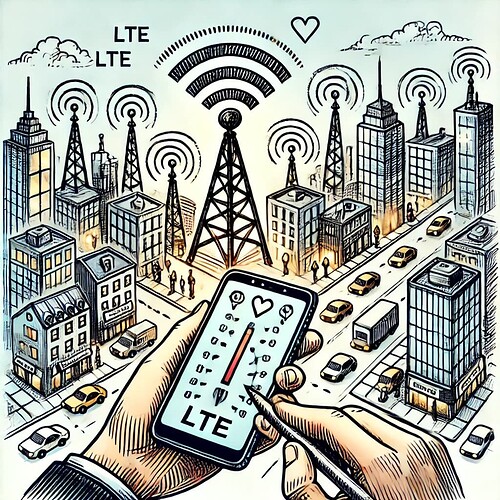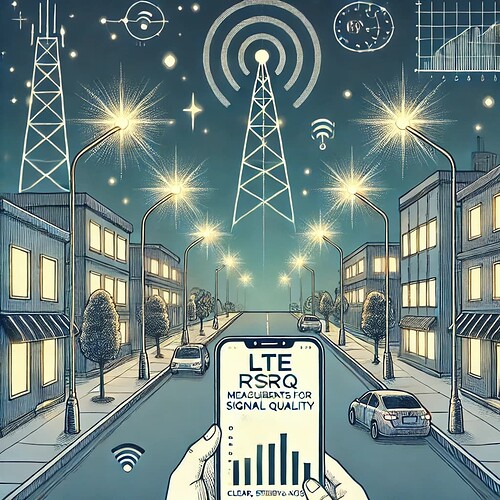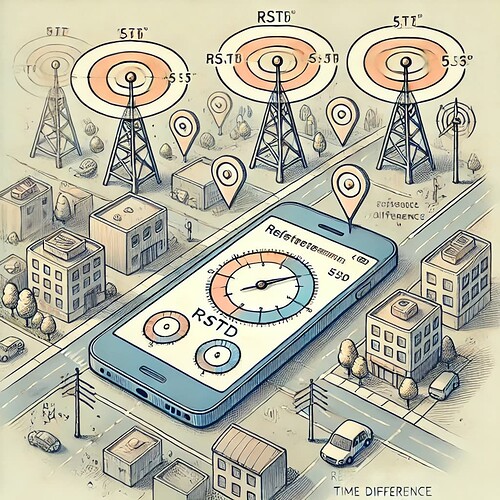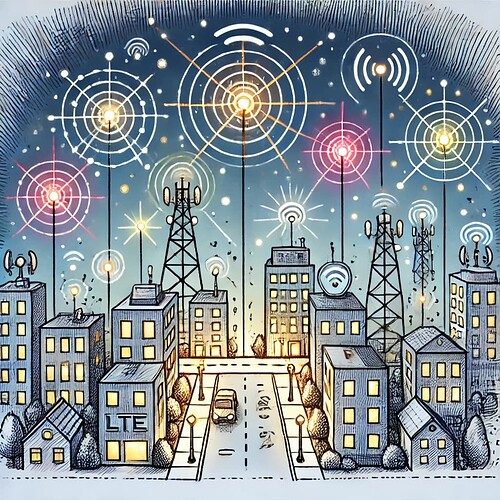This topic presents in a very simplified way all the main concepts that should be understood by those who know LTE.
LTE Measurements
LTE Measurements taken either by the device (UE) or the cell tower, and involving signals received from either cell towers or devices, collectively help the LTE network provide fast, reliable, and consistent service by constantly checking, adjusting, and improving signal performance.Together, these LTE measurements - whether done by the device (UE) or cell tower - help maintain strong, fast, and reliable connections across the network by constantly checking and adjusting signal performance.
![]() Imagine LTE as a bustling city where information moves like cars, packages, and signals on busy streets. Devices, like our phones, constantly check the roads and signals to ensure messages, videos, and calls reach us smoothly. These checks - done by our phones and cell towers - keep the LTE city running seamlessly, allowing data to flow quickly and signals to reach us clearly, so we can connect, call, and stream without interruptions.
Imagine LTE as a bustling city where information moves like cars, packages, and signals on busy streets. Devices, like our phones, constantly check the roads and signals to ensure messages, videos, and calls reach us smoothly. These checks - done by our phones and cell towers - keep the LTE city running seamlessly, allowing data to flow quickly and signals to reach us clearly, so we can connect, call, and stream without interruptions.
Skip to: Roadmap to LTE
- LTE UE Measurements
- RSRP
- RSRQ
- RSTD
- UE RX-TX Time Difference
- LTE Network Measurements
- Reference Signal TX Power
- Received Interference Power
- Thermal Noise Power
- Network RX-TX Time Difference
- Timing Advance
- Angle of Arrival
LTE UE Measurements
LTE UE Measurements are tests that a device (UE) performs to check the quality and strength of signals it receives from the LTE network. These help the network keep connections strong and data flowing fast, even as users move around. (Measured by UE, received from cell towers) These measurements are like check-ups for your device to ensure everything is functioning correctly.
![]() LTE UE Measurements are like our phone checking how strong and clear the signals are from the city checkpoints (cell towers), helping it stay connected without dropping calls or losing data. (Measured by the phone, based on signals from cell towers.) Think of these as city inspectors ensuring everything in the city runs smoothly, making sure connections stay strong and reliable.
LTE UE Measurements are like our phone checking how strong and clear the signals are from the city checkpoints (cell towers), helping it stay connected without dropping calls or losing data. (Measured by the phone, based on signals from cell towers.) Think of these as city inspectors ensuring everything in the city runs smoothly, making sure connections stay strong and reliable.
RSRP
RSRP (Reference Signal Received Power) measures how strong the reference signals from cell towers are when they reach the device. Stronger RSRP usually means better connection quality and reliability. (Measured by UE, received from cell towers). RSRP measures the strength of the signal your device receives from the network’s cell towers. It’s like seeing how many bars of signal you have on your phone, indicating the quality of your connection.
![]() RSRP is like checking how bright the streetlights (signals) are in the city - brighter lights mean a stronger signal, helping your phone stay connected. (Measured by the phone, based on signals from cell towers.) Alternatively, RSRP is like measuring how loud the music is at a concert; it gauges the signal strength from the network’s towers to your device, ensuring you can “hear” the network clearly.
RSRP is like checking how bright the streetlights (signals) are in the city - brighter lights mean a stronger signal, helping your phone stay connected. (Measured by the phone, based on signals from cell towers.) Alternatively, RSRP is like measuring how loud the music is at a concert; it gauges the signal strength from the network’s towers to your device, ensuring you can “hear” the network clearly.
- Search Forum
 LTE RSRP
LTE RSRP 
RSRQ
RSRQ (Reference Signal Received Quality) checks how clear the signal is, factoring in interference from other signals. High RSRQ values indicate a clean signal with fewer interruptions, leading to faster data speeds. (Measured by UE, received from cell towers). RSRQ assesses the quality of the received signal by looking at both signal strength and interference levels. It’s like not only checking how many bars you have but also how clear your call is.
![]() RSRQ is like checking if the streetlight is steady or flickering- if it’s steady and bright, the phone knows it’s receiving a good, clear, reliable signal. (Measured by the phone, based on signals from cell towers.) Alternatively, RSRQ is like assessing both the volume and clarity of music, ensuring there’s no interference or noise disrupting the connection quality.
RSRQ is like checking if the streetlight is steady or flickering- if it’s steady and bright, the phone knows it’s receiving a good, clear, reliable signal. (Measured by the phone, based on signals from cell towers.) Alternatively, RSRQ is like assessing both the volume and clarity of music, ensuring there’s no interference or noise disrupting the connection quality.
- Search Forum
 LTE RSRQ
LTE RSRQ 
RSTD
RSTD (Reference Signal Time Difference) measures the time difference between reference signals from neighboring cell towers. This helps the network locate the device accurately and supports seamless handovers between cells. (Measured by UE, received from neighboring cell towers). RSTD measures the timing differences between signals received from different cell towers.
![]() RSTD measures the time difference between signals from nearby checkpoints. It’s like the phone timing how long it takes to spot each light, helping it figure out its location in the city and switch between checkpoints smoothly as it moves. (Measured by the phone, based on signals from cell towers.) Alternatively, RSTD is like comparing the arrival times of sounds from different directions to estimate their distances, helping the network sync signals from various towers and maintain smooth coordination.
RSTD measures the time difference between signals from nearby checkpoints. It’s like the phone timing how long it takes to spot each light, helping it figure out its location in the city and switch between checkpoints smoothly as it moves. (Measured by the phone, based on signals from cell towers.) Alternatively, RSTD is like comparing the arrival times of sounds from different directions to estimate their distances, helping the network sync signals from various towers and maintain smooth coordination.
- Search Forum
 LTE RSTD
LTE RSTD 
UE RX-TX Time Difference
UE RX-TX Time Difference is the time gap from the UE’s perspective between receiving and sending signals to the network. This helps manage delays and ensures smoother communication, especially in real-time applications like calls. (Measured by UE, involves signals exchanged with cell towers). This measures the difference in timing between receiving and sending signals on your device. It ensures that everything is synchronized properly, maintaining efficient communication with the network.
![]() UE RX-TX Time Difference is like our phone checking how long it takes to send a message and receive a reply. If the response takes too long, it might mean there’s some delay, so the phone uses this information to avoid lag in calls and messages. (Measured by the phone, involving signals going back and forth with cell towers.) It’s like making sure all the city’s clocks are in sync, checking the timing between receiving and sending signals to ensure smooth communication.
UE RX-TX Time Difference is like our phone checking how long it takes to send a message and receive a reply. If the response takes too long, it might mean there’s some delay, so the phone uses this information to avoid lag in calls and messages. (Measured by the phone, involving signals going back and forth with cell towers.) It’s like making sure all the city’s clocks are in sync, checking the timing between receiving and sending signals to ensure smooth communication.
- Search Forum
 LTE UE RX-TX Time Difference
LTE UE RX-TX Time Difference 
LTE Network Measurements
LTE Network Measurements are checks the network itself performs to maintain signal quality, minimize interference, and optimize overall performance. These measurements help ensure each device gets the best possible connection. (Measured by cell towers, involving signals from devices). Think of it as the network’s way of keeping track of all connected devices to ensure everything runs smoothly.
![]() LTE Network Measurements are checks performed by the city itself (cell towers) to ensure the signals it sends are strong, there’s no congestion, and everything is functioning correctly. (Measured by cell towers, using signals from devices.) These checks are like the city’s own inspectors monitoring all roads and services, keeping tabs on how well everything is running to ensure smooth operation.
LTE Network Measurements are checks performed by the city itself (cell towers) to ensure the signals it sends are strong, there’s no congestion, and everything is functioning correctly. (Measured by cell towers, using signals from devices.) These checks are like the city’s own inspectors monitoring all roads and services, keeping tabs on how well everything is running to ensure smooth operation.
- Search Forum
 LTE Network Measurements
LTE Network Measurements 
Reference Signal TX Power
Reference Signal TX Power is the power level set by the cell tower when transmitting reference signals. This “volume” level helps the UE gauge signal strength and is carefully adjusted to balance signal reach and energy use. (Configured by cell tower, used by UE to assess signal strength). This measures the power level at which the network sends out reference signals. Higher power levels can help improve the reach and clarity of the signals, like turning up the volume to be heard better.
![]() Reference Signal TX Power is the power level set by the cell tower, like the brightness of streetlights. The city decides how bright these lights should be so everyone can see them clearly without wasting energy. (Configured by the cell tower, used by the phone to assess signal strength.) Alternatively, it’s like measuring the strength of the city’s radio tower broadcasts - turning up the volume so everyone in the city can hear announcements clearly.
Reference Signal TX Power is the power level set by the cell tower, like the brightness of streetlights. The city decides how bright these lights should be so everyone can see them clearly without wasting energy. (Configured by the cell tower, used by the phone to assess signal strength.) Alternatively, it’s like measuring the strength of the city’s radio tower broadcasts - turning up the volume so everyone in the city can hear announcements clearly.
- Search Forum
 LTE Reference Signal TX Power
LTE Reference Signal TX Power 
Received Interference Power
Received Interference Power measures how much unwanted signal interference is present in the network. High interference can weaken LTE signals, so the network uses this measurement to make adjustments that improve connection quality. (Measured by cell towers, involving all received signals). This measures the amount of interference affecting the signal your device receives. It’s like checking for background noise that might interrupt your conversation.
![]() Received Interference Power measures how much unwanted noise or signals are around. It’s like checking if there are other bright lights making it hard to see the main streetlights. The city checks this to keep our connection strong and clear. (Measured by cell towers from all signals around.) This measures how much background noise is affecting the signals. It’s like checking for static on a radio station, which can mess with the sound quality.
Received Interference Power measures how much unwanted noise or signals are around. It’s like checking if there are other bright lights making it hard to see the main streetlights. The city checks this to keep our connection strong and clear. (Measured by cell towers from all signals around.) This measures how much background noise is affecting the signals. It’s like checking for static on a radio station, which can mess with the sound quality.
- Search Forum
 LTE Received Interference Power
LTE Received Interference Power 
Thermal Noise Power
Thermal Noise Power is the natural background noise generated by random electronic activity from devices and towers. The network measures this noise to filter it out, keeping data transmission clear and avoiding interference. (Measured by cell towers, inherent background noise). It measures the noise generated by electronic components in the network. It’s like the static you hear on a poorly tuned radio, which can affect the clarity of the signal.
![]() Thermal Noise Power is like the quiet hum of the city that’s always present. Every phone and tower generates a bit of this background noise, and the city works to filter it out, ensuring our calls and data stay clear. (Measured by cell towers as natural background noise.) This measures the noise created by electronic equipment in the city - think of it as the hum of machines that can add a subtle layer of noise to the signals.
Thermal Noise Power is like the quiet hum of the city that’s always present. Every phone and tower generates a bit of this background noise, and the city works to filter it out, ensuring our calls and data stay clear. (Measured by cell towers as natural background noise.) This measures the noise created by electronic equipment in the city - think of it as the hum of machines that can add a subtle layer of noise to the signals.
- Search Forum
 LTE Thermal Noise Power
LTE Thermal Noise Power 
Network RX-TX Time Difference
Network RX-TX Time Difference is the time gap from the network’s perspective between receiving and sending signals to devices. This helps the network manage timing and support real-time data flow across multiple devices. (Measured by cell towers, involves signals exchanged with UEs). This ensures that the timing of signals is synchronized on the network’s end, helping to maintain smooth and coordinated communication.
![]() Network RX-TX Time Difference is the time the city takes to receive a message from our phone and then send a reply. This helps the city manage timing so it can keep up with each phone, especially when there’s a lot of data to handle. (Measured by cell towers, involving signals with phones.) This also ensures that all clocks in the city are synchronized, focusing on timing to keep everything in order.
Network RX-TX Time Difference is the time the city takes to receive a message from our phone and then send a reply. This helps the city manage timing so it can keep up with each phone, especially when there’s a lot of data to handle. (Measured by cell towers, involving signals with phones.) This also ensures that all clocks in the city are synchronized, focusing on timing to keep everything in order.
- Search Forum
 LTE Network RX-TX Time Difference
LTE Network RX-TX Time Difference 
Timing Advance
Timing Advance is the network’s way of organizing signal timing for different devices, keeping them in sync regardless of distance. This timing ensures data flows smoothly, even when many devices connect at once. (Calculated by cell tower, based on signals received from devices). Timing Advance adjusts the timing of signals sent from your device to ensure they reach the network’s towers at the right time.
![]() Timing Advance is the city’s way of ensuring each phone sends its signal at the right time. It’s like guiding every car to stay in sync with others on the road, even if some are closer to the checkpoint and others are farther away. (Controlled by cell towers, based on signals from phones.) Timing Advance is like advising people to leave home earlier to avoid traffic and arrive on time. It adjusts the timing of signals to ensure they reach the network towers accurately.
Timing Advance is the city’s way of ensuring each phone sends its signal at the right time. It’s like guiding every car to stay in sync with others on the road, even if some are closer to the checkpoint and others are farther away. (Controlled by cell towers, based on signals from phones.) Timing Advance is like advising people to leave home earlier to avoid traffic and arrive on time. It adjusts the timing of signals to ensure they reach the network towers accurately.
- Search Forum
 LTE Timing Advance
LTE Timing Advance 
Angle of Arrival
Angle of Arrival measures the direction from which signals reach the cell tower from the device. This information helps the network determine the device’s location and movement, which improves accurate signal routing. (Measured by cell towers, involving signals from devices). This measures the direction from which a signal arrives at the network’s antennas.
![]() Angle of Arrival checks the angle at which signals reach the checkpoint from each phone. It’s like knowing which direction a car is coming from, helping the city keep track of where each phone is, making the signals faster and clearer. (Measured by cell towers, involving signals from phones.) This measures the direction from which a signal arrives at the network’s antennas. Alternatively, it’s like figuring out which direction a sound is coming from, helping the city locate and optimize connections.
Angle of Arrival checks the angle at which signals reach the checkpoint from each phone. It’s like knowing which direction a car is coming from, helping the city keep track of where each phone is, making the signals faster and clearer. (Measured by cell towers, involving signals from phones.) This measures the direction from which a signal arrives at the network’s antennas. Alternatively, it’s like figuring out which direction a sound is coming from, helping the city locate and optimize connections.
- Search Forum
 LTE Angle of Arrival
LTE Angle of Arrival 
That’s it. ![]()
-
Continue reading: Roadmap to LTE - Measurement Reporting
-
Or back to: Roadmap to LTE












